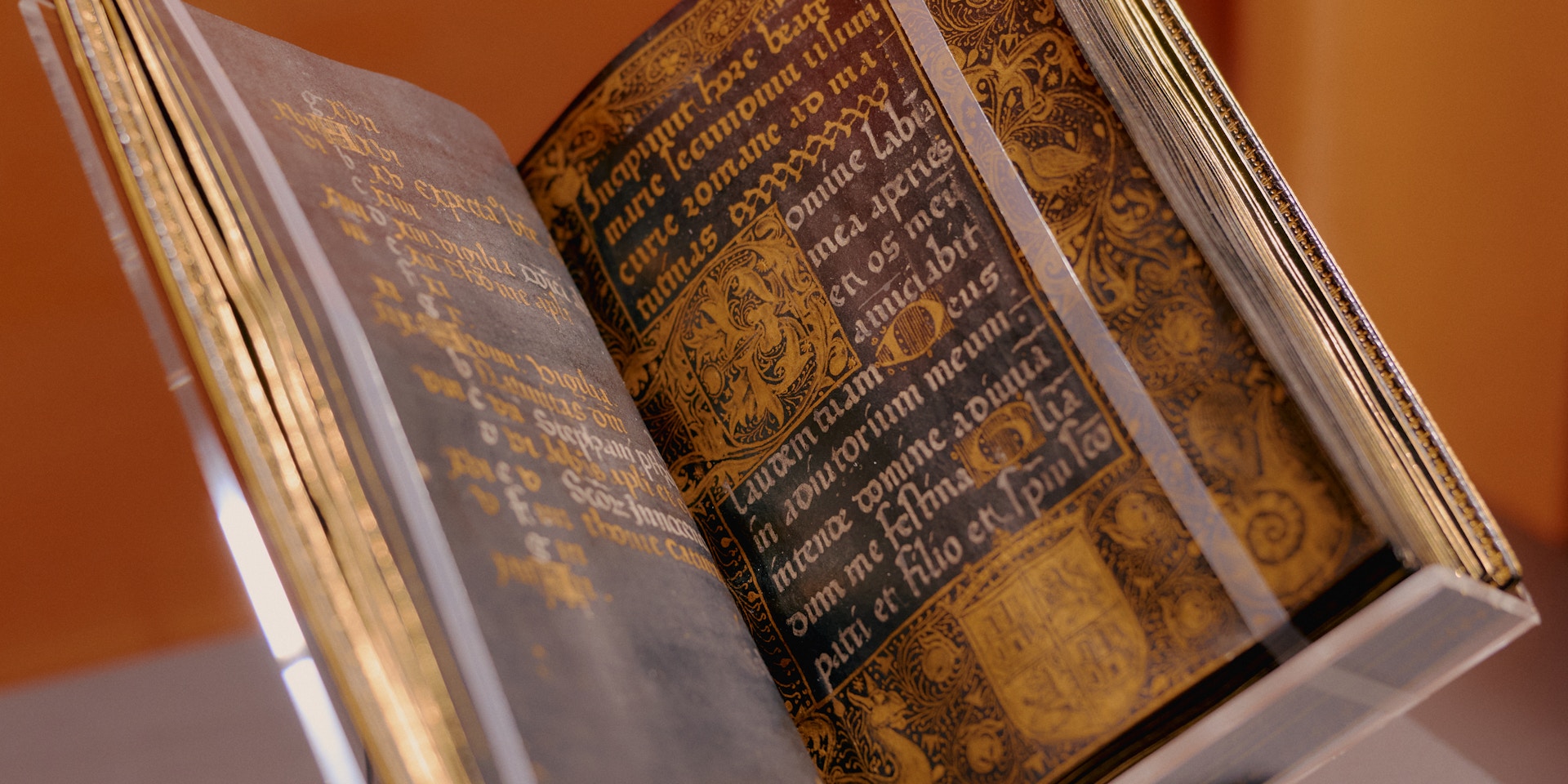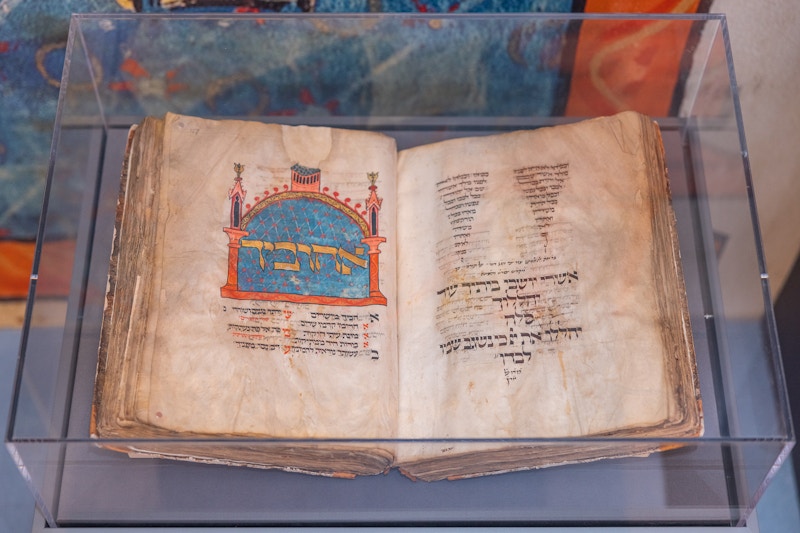
The Black Book of Hours from the collection of The Hispanic Society Museum & Library, on display at TEFAF New York 2025. Photo: Vincent Tullo.
Explore the 2025 New York TEFAF Museum Restoration Fund Recipient
Together with Bank of America, the fund will support the restoration of a rare 15th-century Black Book of Hours from the collection of The Hispanic Society Museum & Library
- By Alina Arcari
- Museum Restoration Fund
Since 2012, the TEFAF Museum Restoration Fund (TMRF) has supported and promoted the professional restoration and related scholarly research of significant museum artworks. Overseen by a committee of independent experts, with a commitment to champion art in all its forms, the global grant application process welcomes submissions from museums worldwide and is open to artworks from any period. In 2025, the New York TMRF has been awarded to The Hispanic Society Museum & Library for the restoration of Horae beatae marie secundum usum curie romane, also known as the Black Book of Hours (c. 1458).
An exciting new partnership with Bank of America’s Art Conservation Project has allowed the TMRF to strengthen its impact this year through the gracious support of the restoration project of the The Hispanic Society Museum & Library. Bank of America—who has been the Lead Partner of TEFAF New York since 2017—is one of the leading corporate supporters of the arts around the world. The Bank of America Conservation Project has funded more than 260 projects in forty countries since it began in 2010. TEFAF and Bank of America are both committed to ensuring that works of art and cultural treasures are not lost to the impacts of time and believe strongly in providing funding so that they can be enjoyed by future generations.

The Black Book of Hours from the collection of The Hispanic Society Museum & Library, on display at TEFAF New York 2025. Photo: Vincent Tullo.
Since its founding in 1904, The Hispanic Society Museum & Library has served as a vital institution for the study and celebration of the arts and cultures of Spain, Portugal, Latin America, and the Philippines. Operating as a museum and library, the Society houses a collection of more than 900 paintings, featuring masterpieces by El Greco, Velázquez, Goya, and Sorolla, as well as 6,000 watercolors and drawings. The library complements the museum collection with over 250,000 works spanning the 11th through to the 20th century, making the Society one of the world’s foremost resources for the study of Hispanic art and culture.
With the support of the TMRF and the new collaboration with the Bank of America Art Conservation Project, The Hispanic Society Museum & Library will undertake the restoration of the Black Book of Hours, one of the most requested items in its collection and one of only seven known black books created on colored parchment. These exceptionally rare books of hours, illuminated on vellum stained or painted black, all originate from the latter half of the 15th century. This particular manuscript is notable as the earliest known example of its kind.
Commissioned for or by María of Castile as a mourning gift following the death of her husband, Alfonso V of Aragon, in 1458, the book remained unfinished upon María’s own death just three months later. While the text was complete, no attempt was made to initiate the planned miniatures that were to adorn the beginning of each office. Guillaume Kientz, Director and CEO of The Hispanic Society Museum & Library, highlights the significance of the manuscript: “Given the extreme rarity of manuscripts of this nature, The Hispanic Society Museum & Library is indeed fortunate to own such a fine example, coincidentally the earliest known example of a black book of hours. It is one of the gems of our collection and never fails to delight and astound the general public and excite and intrigue researchers.” An initial analysis of the black dye used on the parchment has revealed the presence of carbon, similar to the Black Book of Hours in the Morgan Library & Museum in New York. A stylistic comparison of the illuminations and decorations suggests that The Hispanic Society Museum & Library’s manuscript was created in the same workshop in Bruges by an illuminator from the circle of Willem Vrelant.

The Black Book of Hours from the collection of The Hispanic Society Museum & Library, on display at TEFAF New York 2025. Photo: TEFAF.
In the 19th century, the Society’s Black Book of Hours was rebound in a gilded dark blue Morocco binding, during which pages were trimmed and the edges gilded. While the parchment, silver and gold lettering, along with the gilded illustrations across the 149 folios, remain in good condition, some undecorated pages show signs of bloom, and the binding is extremely tight, restricting the volume to a maximum opening of 45 degrees. “The image most frequently displayed is at the front of the volume, which makes any kind of examination or display very challenging,” notes Hélène Fontoira, Head of Conservation. Following an exhibition in 2018, the need to have the volume digitally photographed became pressing, after exposure to high levels of pollution caused significant oxidation of the silver in the manuscript.
After being examined by conservation staff from the Morgan Library and the Metropolitan Museum of Art’s Department of Scientific Research the same year, it was determined that the volume should be disbound and a comparative analysis undertaken. However, the pandemic disrupted both the fundraising and conservation efforts. “The conservation treatment will contribute to the preservation of this work by liberating it from its 19th- century binding and allow us to devise more appropriate and safer long-term housing for this work. It will enable the display of pages hitherto unpublished and only previously seen by a tiny number of scholars. We are also excited to be able to contribute to the growing body of research being conducted at a growing number of institutions on these extraordinary and beautiful manuscripts,” shares Monica Katz, Conservator Emerita at The Hispanic Society Museum & Library.


